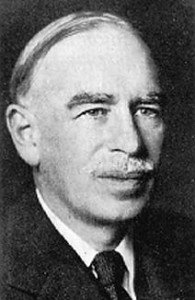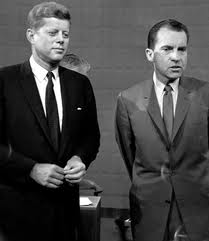Politicians as Economic Arsonists
Allowing politicians to make economic policy decisions is akin to allowing arsonists to investigate fires or run fire departments.
By Monty Pelerin
 Economic problems tend to be viewed as short-term problems. John Maynard Keynes disparaged long-term thinking and solutions with his famous phrase:
Economic problems tend to be viewed as short-term problems. John Maynard Keynes disparaged long-term thinking and solutions with his famous phrase:

John Maynard Keynes
dead.” His retort was clever, defensive and very appealing to politicians whose time horizon is never longer than the next election.
Unfortunately, while a short-term focus may be necessary in politics, it makes for horrible economics. Allowing politicians to make economic policy decisions is akin to allowing arsonists to investigate fires or run fire departments.
As we struggle with the greatest, most prolonged economic downturn since the 1930s, virtually all nostrums are short-term oriented. Some of the more popular solutions, all of which have been tried, include the following:
- Lower interest rates to stimulate the economy
- Higher government spending to (appear to) increase aggregate demand
- Looser money and credit to inflate the problem away
The urgency of the moment trumps good economics as politics dominates proper economic solutions. The cost of such policies goes beyond the current crisis. There is a cumulative effect to short-term fixes in addition to the immediate costs. Quick political fixes solve little and debilitate an economy over the longer term. Living for the moment produces neither a long life nor a healthy economy.
 The process of “short-termism” gained acceptance with the publication of Keynes’ General Theory in 1936. It began to dominate US government economic policy in the 1960s when the term “the best and the brightest” was applied to John F. Kennedy’s advisors. All of his economic team were Keynesians.
The process of “short-termism” gained acceptance with the publication of Keynes’ General Theory in 1936. It began to dominate US government economic policy in the 1960s when the term “the best and the brightest” was applied to John F. Kennedy’s advisors. All of his economic team were Keynesians.
Camelot produced more than its share of hubris in the economic area. The notion that an economy could be “managed” and that business cycles could be tamed and even eliminated prevailed. Much of this bravado still prevails in the economics profession today.
In 1971, an under-appreciated event occurred — the detachment of all fiat currencies from anything of value. Richard M. Nixon closed the gold window, taking the US dollar off what remained of a weakened gold standard. Whether Nixon approved of the policy or not is irrelevant. He had no choice as the US was losing gold as a result of dollar redemption at a pace that would have bankrupted (in terms of gold) the country. The “New Economics” that had prevailed since the Kennedy Administration had bankrupted the country, at least in terms of gold. Without the constraint of gold, it was now in a position to truly bankrupt the country in terms of debt.
From 1971 forward, there were no constraints on currencies. The immediate impact resulted in double-digit interest and inflation rates in the late 70s-early 80s primarily as a result of Jimmy Carter’s economic and monetary policies. Since the Carter era, the country has avoided reporting double-digit results in both categories. However, loose monetary policy and aggressive fiscal policy have become the norm.
Our current economic crisis is not the product of a normal business cycle. It is the inevitable result of decades of unwise, politically-driven, short-term economic policies. The current event is a secular rather than a cyclical problem. It cannot be resolved with cyclical remedies which will only make matters worse.
The following article by Nathan Lewis, entitled Who Destroyed The Middle Class?, is a discussion of just this issue. It is an important piece, if you want to understand how we got to our current condition and what needs to be done to return to prosperity. Here is Mr. Lewis’ take:
The difficulties experienced by the great middle in the U.S. can be, in my opinion, traced to the delinking of the U.S. dollar from gold in 1971. Now, I know a lot of people are going to say that is ridiculous. But, one reason I say that is, even by the U.S. government’s own statistics, the income of the median full-time male worker begins to stagnate at exactly that point, after rising by huge amounts during the 1950s and 1960s.
The median U.S. full-time male income was $47,715 in 2010. In 1969, it was $44,455. The 1969 numbers are of course “adjusted for inflation,” and you know that the government’s inflation adjustments are thoroughly low-balled. With slightly more honest statistics, the trend would not be flat, but instead downward over the past forty years.
Another way of looking at it is in terms of ounces of gold. After all, gold was the monetary basis of the United States for 182 years, from 1789 to 1971, so why shouldn’t we use that as a measure of how much people are really getting paid?
Our median worker, in 1969, made $8,668 nominal. But, in those days, the dollar was worth 1/35th of an ounce of gold. It works out to 248 ounces of gold. In 2010, the dollar’s value was, on average, about 1/1224th of an ounce of gold, and the full-time male worker was making only 39 ounces of gold. This figure exaggerates the situation somewhat, due to the rapid decline of the dollar vs. gold in recent years, but it describes, I would say, the economic reality of the situation.
Think of it like this: what if, in year 1, the average Mexican full-time male worker was making 8,668 pesos per year, and the peso’s value was one peso per dollar. The Mexican worker is making the monetary equivalent of $8,448. In year 40, after four decades of “easy money” and currency deterioration, the average Mexican worker is making 47,715 pesos, but the peso’s value has fallen to 35 pesos per dollar. We can see that the Mexican worker is making only $1,363, and no amount of government statistical tomfoolery or “purchasing power parity” arguments will change that fundamental fact.
The fact that you can buy an iPad in Mexico City today, while forty years ago you would have to make do with a television set based on vacuum tubes, doesn’t change the fact that the Mexican worker is making less. For some reason, we are able to see these things easily when I take the hypothetical example of a Mexican worker, but Americans are prone to states of denial when asked to consider that maybe a similar thing has been happening to them.
This is why you “can’t devalue yourself to prosperity.” “Prosperity” mostly means higher wages. But, each time you devalue the currency, wages tend to go down in real terms, even if they go up in nominal terms.
The Keynesians are quick to argue that their “easy money” policies will lead to a reduction in unemployment. Sometimes, this works (though not always). It often works because, when wages have been lowered via currency devaluation, then there is more demand for labor due to the lower price. Currency devaluation might help the unemployed, but it hurts the employed – always a much larger number – because their wages have been effectively cut.
Not only do things line up perfectly in terms of timing, but it makes sense on a theoretical basis too, because stagnation and indeed a real decline in wages is exactly the outcome you would expect from a funny-money policy.
However, that is not the only thing that happened to the U.S. middle class in those years … [Continue Reading]
“Monty Pelerin” is a pseudonym derived from The Mont Pelerin Society. The writer has no connection with the Society (other than coincidence of philosophy). Nothing said by me should be considered to be representative of the views of the Mont Pelerin Society or any of its members. “Monty Pelerin” blogs at Monty Pelerin’s World
Help Make A Difference By Sharing These Articles On Facebook, Twitter And Elsewhere:
